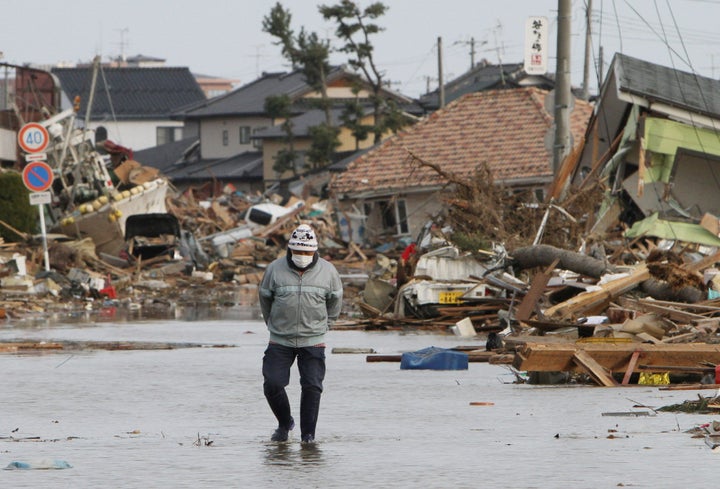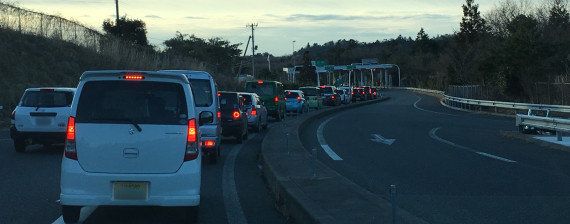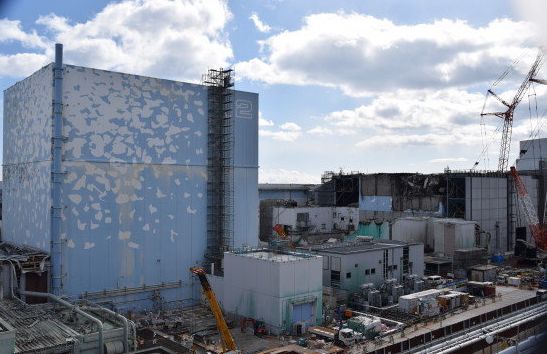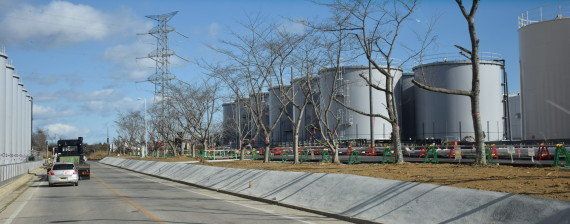
TOKYO -- In 2011, a magnitude 9.0 earthquake struck off the shores of Japan's main island, resulting in a tsunami that devastated the towns on the country's northeastern coastline and claimed more than 15,000 lives.
The earthquake and tsunami caught many Japanese scientists by surprise and revealed fortified structures to be vulnerable. Enormous waves surmounted nearly 19-foot seawalls, and water quickly flooded the Fukushima Daiichi Nuclear Power Plant, triggering a series of disasters that would eventually result in the meltdown of three of the plant's six nuclear reactors.
Five years later, the shock still reverberates, stirring concern about the future of nuclear energy in Japan as Tokyo Electric Power Co, the operator of the now defunct Fukushima Daiichi Plant, attempts to reopen reactors throughout the country.
Meanwhile, the cleanup and decontamination effort at the Fukushima Daiichi plant is ongoing, with the goal of collecting and treating contaminated water in the vicinity of the reactors by 2020.
The Japanese government has undertaken a $15 billion plan to decontaminate more than 100 cities affected by the meltdowns at the Fukushima Daiichi plant and prepare them for the return of their evacuated residents. However, the authorities are having trouble disposing of the radioactive waste, a lot of which is currently being shuffled from one location to another in Fukushima. Radiation-contaminated soil and debris stuffed in black bags also lie around, waiting to be transported.
The situation remains worrying in Fukushima; the state of emergency announced the day the earthquake hit still has not been formally revoked. There are still concerns regarding women working at the radioactive plant -- cancer risks from radiation are generally higher among women.
Female workers were allowed to return to specific areas of the plant when the amount of radiation there hit a low in 2014. As of this month, only 40 out of the 6,500 workers at Fukushima Daiichi are women. Their tasks range from back-office operations to cooking for employees and cleaning workspaces.
Airi Ide is one of them. She has worked as a nuclear reactor operator at Fukushima Daiichi for more than 10 years and has two children, a 4-year-old and a 1-year-old.
We spoke with her late last month to find out why -- despite the potential danger -- she chose to stay.

Ide started working for Tokyo Electric in 2001 as an operator for reactors five and six at Fukushima Daiichi.
When the earthquake struck, at 2:46 p.m. on March 11, Ide was in an office on the same floor as the central control room for reactors five and six. As the aftershocks came, she grabbed onto a handrail and made her way to the central control room. She made sure the huge gauges were not showing any abnormal radiation rates, she said.
She found out about the tsunami when her husband, who was a security guard for reactors five and six, called her on the in-house phone. After the earthquake hit, he had retreated to a hillside building, and from there, he saw the tsunami.
"He was yelling -- I had never heard his voice like that before," she said. "I told the other employees in the control room what he told me."

Fukushima Daiichi had lost all external power in the earthquake. Reactors one through six had emergency diesel power generators and ocean water cooling pumps one level below ground, but these flooded in the tsunami and stopped working. Reactors five and six were not operating because they were in the middle of a routine inspection, but they were still loaded with nuclear fuel. If the fuel rods weren’t being continuously cooled with water, there was a danger they could become exposed.
Fortunately, the emergency diesel power generator for one of the air cooling systems for reactor six escaped the flooding. The workers at the plant used the diesel generator to cool reactor six, and hooked up reactor five to the generator as well. They needed to cool down reactor five as quickly as possible.
"This will be a long battle," thought Ide, as she mentally prepared herself for the difficult night ahead.
Reactor one stood about 650 yards south of reactors five and six. At around 7:30 p.m., its nuclear reactor core started to sustain damage. In the evening, rising radiation levels were confirmed in the vicinity of reactors one and two. By nighttime, rising radiation levels in the area by the main entrance of the plant was also detected.
At this time, Ide was in the first trimester of her first pregnancy.
“The road had been straight, and now it was twisted and bent. The scenery I was used to seeing had changed completely. I felt like I was watching a movie.”
A coworker told her, "You're pregnant, so shouldn't you be the first to evacuate? Anxiety is not good for the baby." Neither is radiation: pregnant women should not be exposed to more than 2 millisieverts of radiation to the surface of the abdomen throughout the entire pregnancy. That's the equivalent of one-fiftieth of the amount radiation workers are normally exposed to. But there was a lot of work to be done and Ide was nervous about leaving and seeking shelter on her own in the middle of the night.
She stayed at the plant, and the next morning, other employees came to help them move to a safer spot.
“There was no clear space to walk [outside]. The road had been straight, and now it was twisted and bent. The scenery I was used to seeing had changed completely. I felt like I was watching a movie," she recounted.

That afternoon, there was a hydrogen explosion at reactor one.
Many of the plant's workers, including women, chose to stay on the scene to help deploy and direct emergency vehicles.
Ide's eldest son was born a few months after the meltdown, in September of 2011. Up until the birth, she was worried, but she says he is perfectly healthy.
Her maternity leave ended in October 2012. At that point, women were still not allowed to return to Fukushima Daiichi, and she began working at the Fukushima Daini Nuclear Power Plant, located about 7 miles south of Fukushima Daiichi.
The building at Fukushima Daini that housed the nuclear reactors was also hit by the tsunami, but it managed to stay connected to a power source, so a crisis was averted. Still, the town of Naraha, where Fukushima Daini is located, had to be evacuated.
While many of her coworkers quit, Ide said she never considered it.
"First, I wanted to see with my own eyes what was becoming of this plant I had been involved with for more than 10 years," she said. "I wanted to come back to work somehow, and participate in the decommissioning of the reactor. I thought there must be a way I could be of use. I felt strongly about this."

But while working at Fukushima Daiichi and Fukushima Daini and trying to raise a child, Ide encountered difficulties she had not faced before the earthquake. The commute was her main problem.
After the meltdown, access to any place within a 12-mile radius Fukushima Daiichi was severely restricted, so that radioactive debris could be removed and dust could be stabilized. Many residents relocated, and most towns are just now starting to be repopulated.
The government and Tokyo Electric turned J-Village, previously a soccer training center located about 12 miles south of Fukushima Daiichi, into their frontline base. They blockaded roads so that anyone going to Fukushima Daiichi had to pass through J-Village.
Ide had evacuated her apartment in Okuma, the town where the Fukushima Daiichi plant is, and relocated to Iwaki. The road from Iwaki to J-Village was often jammed with cars, and the drive took her about an hour. Commuting from J-Village to Fukushima Daini also meant getting caught up in congested traffic.

She requested short workdays, but it still took her over an hour to pick up her son from nursery school. She worried about being unable to get to the school quickly in an emergency.
It was after she had a second child and her maternity leave ended, in April 2015, that Ide returned to Fukushima Daiichi. She has been working there since. She works in a new building on a mountainside, about half a mile from the buildings that house reactors one through six. The Japanese government recently put the average radiation levels in Naraha at 1.2 millisieverts a year.
Two months after she came back to work, she was given permission to see the plant premises.
"When we went past reactors one through four on the bus, it just looked so different from how it was before. I thought to myself, they're in quite a state," she said. "I got them to let me into the central control room for reactors one and two, and they too were completely different. It was a huge shock."

In December 2014, the last fuel remaining in the pool of used fuel at reactor four was removed. But melted fuel still remains in the buildings housing reactors one through three, which had meltdowns, and the long process of removing it hasn't gotten beyond the beginning stages.
After coming back to work, Ide donned a protective suit three times a month and went into the buildings housing reactors five and six to do maintenance work. Those reactors are in a state of cold shutdown, and there are future plans to establish facilities there to research how to get rid of the melted fuel in reactors one through three.
Ide emphasized that they are making progress in decommissioning the reactors.
"People think that radiation levels in that area are high, and that they'll get irradiated. But there are places where the levels are so low you can't even measure them with an EPD [a device that measures radiation]."

"Fukushima Daiichi was in such a damaged state, but now it's being put in order and kept under control," she said.
Ide is currently pregnant with her third child. She won't be able to commute to the plant for a little while, but says she will keep working at the office until her maternity leave.
This post first appeared on HuffPost Japan. It has been translated into English and edited for clarity.